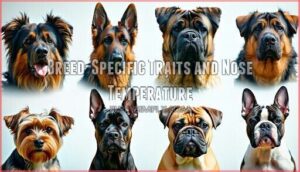This site is supported by our readers. We may earn a commission, at no cost to you, if you purchase through links.
 Your dog’s nose doesn’t need to be cold to indicate good health.
Your dog’s nose doesn’t need to be cold to indicate good health.
While many people believe a cold, wet nose means your pup is healthy, this old wives’ tale isn’t entirely accurate.
A dog’s nose temperature naturally changes throughout the day based on activity, sleep, and weather conditions.
You’ll notice your dog’s nose feels warmer after exercise, naps, or during hot weather, and that’s completely normal.
The key is watching for persistent changes rather than moment-to-moment variations.
A consistently dry, cracked, or unusually warm nose paired with other symptoms like lethargy or loss of appetite might signal something worth investigating further, considering the overall health.
Table Of Contents
- Key Takeaways
- Dog Nose Temperature Basics
- Should Dogs Noses Be Cold
- Factors Affecting Dog Nose Temperature
- Health Indicators and Nose Temperature
- Nose Moisture and Temperature Regulation
- What Affects Dog Nose Moisture
- Detecting Health Issues Through Nose
- Dog Nose Temperature and Health
- Maintaining Healthy Dog Nose Temperature
- Monitoring Dog Nose Temperature
- Frequently Asked Questions (FAQs)
- Can a dog have a cold nose?
- Should a dog’s nose be cold or warm?
- Is it normal for a dog’s nose to be cold and wet?
- What temperature should a dog’s nose be?
- Why does a dog’s nose need to be cold?
- Why is my dog’s nose wet and cold?
- Should a dog’s nose be warm or cold?
- Is it okay if my dog’s nose is dry?
- How can I tell if my dog is cold?
- Does a cold wet nose mean a dog is healthy?
- Conclusion
Key Takeaways
- Your dog’s nose temperature naturally changes throughout the day based on activity, sleep, and weather – both warm and cold noses can be perfectly normal, so don’t worry about moment-to-moment variations.
- Focus on persistent changes rather than single temperature checks – a consistently hot, dry nose combined with symptoms like lethargy or loss of appetite might signal health issues worth investigating.
- Your dog’s wet, cold nose helps them smell better and regulate body temperature through natural moisture and evaporation, but a dry nose alone doesn’t indicate illness.
- Monitor your dog’s overall behavior, appetite, and energy levels instead of relying solely on nose temperature – these are much better indicators of your pup’s health and well-being.
Dog Nose Temperature Basics
Your dog’s nose temperature changes throughout the day based on several factors, including their activity level, sleep patterns, and the environment around them.
Your pup’s nose is like a tiny weather station, constantly adjusting to their daily adventures and surroundings.
Understanding these normal variations will help you recognize when temperature changes are typical and when they might signal something that needs your attention, such as a potential health issue that requires veterinary care, which is a key factor in maintaining your dog’s overall health and well-being.
Environmental Factors Affecting Nose Temperature
When considering environmental factors that affect your dog’s nose temperature, several key elements come into play.
Ambient temperature directly influences whether your pup’s nose feels warm or cool to the touch.
Seasonal changes create natural fluctuations, while humidity levels and airflow impact moisture retention.
Direct sunlight can quickly warm the nose, making these dog nose environmental factors essential for understanding normal temperature variations, and how ambient temperature and seasonal changes play a role.
Activity Levels and Nose Temperature
After exercise and warmth from physical activity, your dog’s nose temperature naturally rises.
Panting’s effect creates additional heat, while sniffing intensities during walks can warm the nasal passages.
Post-exercise coolness typically returns within minutes as your pet rests.
Breed activity levels influence how quickly dog nose temperature fluctuates, with active breeds showing more dramatic changes than sedentary ones, which can be considered a key factor in the fluctuates of dog nose temperature.
Sleep Patterns and Nose Temperature
After your dog wakes from a nap, you’ll notice post-sleep warmth in their nose—this is completely normal.
During sleep, dogs don’t lick their noses as frequently, causing natural drying and temperature increases.
REM sleep and circadian rhythm changes affect dog nose temperature fluctuations throughout the day.
The sleep environment also influences these dog nose temperature variabilities, making napping and temperature monitoring important for understanding your pet’s patterns.
Should Dogs Noses Be Cold
You’ve probably wondered whether your dog’s nose should feel cold when you pet them, and the answer isn’t as straightforward as you might think.
A dog’s nose temperature changes throughout the day based on activity levels, sleep patterns, and environmental conditions, so both cold and warm noses can be perfectly normal.
Normal Nose Temperature Variations
Understanding your dog’s nose temperature can feel like solving a puzzle, but it’s actually quite normal for temperatures to shift throughout the day.
Daily fluctuations occur naturally as your pup moves between activities and rest periods. Individual variation means each dog has their own baseline, while breed differences and age influence create unique patterns.
Here’s what affects dog nose temperature variations:
- Morning coolness after sleep
- Midday warmth during activity
- Evening changes with relaxation
- Weather-related environmental impact
The factors influencing nose temperature are crucial for understanding your dog’s health, and recognizing these daily fluctuations and individual variation can help you identify any abnormal changes.
Factors Influencing Nose Temperature
Multiple elements work together to influence your dog’s nose temperature throughout the day. External temperature plays a significant role, with warmer environments naturally increasing nose warmth.
Your dog’s nose is a natural thermometer that responds to the world around them.
Activity impact becomes evident after exercise or play sessions when your pup’s nose feels noticeably warmer. Hydration effects show up as dryness when water intake drops.
Your dog’s emotional state, from stress to contentment, directly affects nose temperature. Age influence means puppies typically have warmer noses than senior dogs due to circulation differences.
External temperature plays a crucial role in nose temperature regulation.
Factors Affecting Dog Nose Temperature
Your dog’s nose temperature changes throughout the day due to several key factors, including their breed, activity level, hydration status, and environmental conditions.
Understanding these influences helps you recognize what’s normal for your pet, since factors like sleep patterns, stress levels, and even the weather can cause natural fluctuations in nose warmth and moisture.
Recognizing these natural fluctuations is crucial for pet owners to ensure their dog’s health and well-being.
Breed-Specific Traits and Nose Temperature
Your dog’s breed substantially impacts nose temperature through anatomical variations.
Snout length affects breed airflow, with brachycephalic breeds like bulldogs having naturally warmer noses due to restricted breathing passages. Meanwhile, longer-snouted breeds maintain cooler temperatures through better ventilation.
Individual physiology within breed variations also matters. Many long-nosed breeds were originally bred for superior scent detection.
Key breed-related factors:
- Olfactory receptors – Some breeds have up to 220 million, affecting nose function
- Dog nose temperature breed differences range from naturally warm to consistently cool
- Dog breeds with flat faces struggle more with temperature regulation than others
Hydration Levels and Nose Temperature
Water intake directly affects your dog’s nose temperature and moisture levels.
When dehydration occurs, you’ll notice a dry, warm nose as one of the first signs.
Proper hydration maintains electrolyte balance, keeping nose moisture at healthy levels.
Monitor your dog’s drinking habits closely, as adequate water consumption helps regulate body temperature through their nose’s natural cooling system.
| Hydration Level | Nose Condition | Temperature | Signs to Watch |
|---|---|---|---|
| Well-hydrated | Moist, cool | Normal | Active, alert behavior |
| Mildly dehydrated | Slightly dry | Warm | Reduced energy levels |
| Moderately dehydrated | Dry, warm | Hot | Excessive panting |
| Severely dehydrated | Cracked, hot | Very hot | Lethargy, weakness |
The table above outlines the relationship between hydration levels and nose condition, highlighting key signs to watch for, such as excessive panting and lethargy.
It is crucial to recognize these signs to ensure your dog’s health and well-being, especially in cases of severe dehydration.
Health Indicators and Nose Temperature
You can use your dog’s nose temperature as one factor to assess their health, but it’s not a standalone indicator of illness.
While a consistently hot, dry nose combined with other symptoms like lethargy or loss of appetite may signal underlying health issues.
Normal nose temperature varies throughout the day based on activity, environment, and your dog’s individual characteristics, and a consistently hot nose can be a sign of something more serious.
Signs of Underlying Health Issues
Warning signs often appear before serious illness strikes. When your dog’s nose shows sudden changes, it’s time to pay attention. Nasal discharge, pigment loss, or altered nose texture can signal underlying issues requiring veterinary attention.
A healthy nose should be moist, but persistent dryness signals issues.
- Thick or bloody nasal discharge – May indicate infection or respiratory problems
- Loss of nose pigment or color changes – Could suggest autoimmune disorders or skin conditions
- Cracking, flaking, or unusual nose texture – Often signals dehydration or dermatitis
- Behavioral changes with nose symptoms – Lethargy or appetite loss alongside nasal issues
- Persistent breathing difficulties – Requires immediate professional evaluation for dog nose health
Persistent Dryness or Warmth in Nose
When your dog’s nose stays dry or warm for days, it’s time to pay attention.
Persistent dryness often signals dehydration signs, while ongoing warmth might indicate infection indicators or allergy symptoms.
A dry dog nose that doesn’t return to normal could suggest autoimmune diseases or even tumor possibility.
Don’t ignore these dog nose problems – they’re important dog nose health signals.
Veterinary Consultation and Nose Temperature
When to consult your veterinarian about dog nose temperature changes?
If you notice concerning symptoms like persistent warmth, excessive dryness, or unusual discharge lasting more than 24 hours, it’s time for veterinary advice.
Your vet can perform diagnostic procedures to identify health indicators and recommend treatment options or preventative care to maintain your dog’s overall health.
Symptoms such as nasal discharge causes warrant veterinary attention.
Nose Moisture and Temperature Regulation
Your dog’s nose works like a natural cooling system, using moisture and temperature changes to regulate body heat and enhance their sense of smell.
The wet, cool surface you feel comes from special glands that produce mucus, which your dog spreads by licking to keep their nose functional and help them stay comfortable.
Role of Mucus in Nose Moisture
Nature’s brilliant design keeps your dog’s nose functioning perfectly through specialized mucus production.
Special glands in your dog’s nasal lining create this moisture, making the dog nose wet and enhancing scent detection abilities.
Here’s how mucus benefits your dog’s nose:
- Scent adhesion – Captures odor molecules more effectively than dry surfaces
- Moisture benefits – Prevents nasal passages from drying out and cracking
- Antibacterial properties – Natural protection against harmful bacteria and pathogens
- Temperature regulation – Helps cool your dog through evaporation
Licking and Nose Moisture
Your dog’s constant nose licking isn’t just a quirky habit—it’s a smart cooling mechanism.
Each lick spreads saliva with anti-bacterial properties across the nose surface, creating moisture benefits that enhance scent detection.
The combination of saliva properties and mucus properties keeps their dog nose wet, ensuring ideal nose moisture for temperature regulation and olfactory function.
The licking frequency increases when your pup explores new environments.
Evaporation and Cooling
Moisture on your dog’s nose acts like nature’s air conditioner through evaporation.
When warm air passes over the wet surface, it creates a cooling efficiency that helps regulate body temperature.
This panting mechanism works alongside nasal airflow to keep your pup comfortable.
Environmental humidity affects how well this process works, making a cold dog nose especially important during hot weather.
What Affects Dog Nose Moisture
Your dog’s nose moisture changes throughout the day based on several key factors, including environmental conditions, activity levels, and natural behaviors like licking.
Understanding these influences helps you recognize what’s normal for your pet, since factors like temperature, humidity, and your dog’s exploration habits all play important roles in keeping their nose wet or dry.
Environmental Factors and Nose Moisture
Several environmental factors directly impact your dog’s nose moisture levels.
Ambient temperature and humidity levels work together to determine how quickly moisture evaporates from your pup’s snout.
Here are key environmental influences on dog nose moisture:
- Humidity levels – Low humidity causes faster moisture evaporation, leading to a dry dog nose
- Airflow impact – Windy conditions increase evaporation rates, affecting nose wetness
- Sun exposure – Direct sunlight can dry out your dog’s nose quickly
- Shelter availability – Indoor environments often have different moisture effects than outdoor spaces
Nasal Discharge or Salivation
How can you tell if your dog’s nasal discharge or salivation is normal?
Your pup’s nose naturally produces mucus, but changes in discharge consistency or color signal potential issues.
Excessive drooling paired with thick nasal discharge may indicate swallowing issues or respiratory problems requiring veterinary attention.
| Discharge Type | Normal Appearance | Concerning Signs |
|---|---|---|
| Nasal Discharge | Clear, thin mucus | Yellow, green, or bloody |
| Saliva Production | Moderate, clear | Excessive drooling, thick |
| Discharge Color | Transparent | Discolored, foul-smelling |
| Consistency | Watery texture | Thick, sticky mucus |
| Frequency | Occasional | Persistent, continuous |
Exploring The Environment and Nose Moisture
When your dog’s out sniffing around, their wet nose acts like a magnet for scent particles.
This moisture helps with scent particle capture, allowing their 220 million olfactory receptors to detect details about everything they encounter.
The Jacobson’s organ processes these particles, helping your pup make decisions about their environment.
Dog nose exploration relies heavily on this natural scent-gathering system, which is made possible by the unique characteristics of a dog’s nose, including its ability to capture and process olfactory receptors.
Detecting Health Issues Through Nose
Your dog’s nose can reveal important health information beyond just temperature and moisture levels.
You should watch for changes in color, texture, discharge, and bleeding, as these signs often indicate underlying medical conditions that require veterinary attention.
Loss of Pigment and Texture
Changes in your dog’s nose color or texture shouldn’t be ignored.
Nose depigmentation and texture changes can signal immune conditions like lupus or pemphigus signs developing.
When dog nose pigmentation fades or becomes rough, it’s your pet’s way of waving a red flag.
These dog nose appearance shifts often indicate underlying autoimmune issues requiring veterinary attention for proper diagnosis.
Golden Retrievers are also prone to skin allergies, which may manifest with similar symptoms.
These health issues can be a sign of a more serious problem, and it’s essential to address them promptly to ensure your dog’s well-being, especially in cases of veterinary attention.
Discharge and Bleeding
Watch for unusual nasal discharge that’s yellow, green, or contains pus—these colors signal infections or foreign bodies lodged in your dog’s nose.
Blood from the nose can indicate nasal tumors, bleeding disorders, or objects stuck inside.
Clear discharge is normal, but thick, colored, or bloody discharge needs immediate veterinary attention to rule out serious conditions.
You can find products for relief if your dog is experiencing nasal discharge.
Accompanying Clinical Signs of Fever or Underlying Illness
When your pup’s nose changes, look beyond the surface for fever symptoms like lethargy causes that signal trouble.
Nasal discharge paired with breathing difficulties, appetite changes, or unusual behavior creates a clearer picture than a dog nose cold alone.
These dog fever symptoms and illness indicators together warrant immediate dog veterinary care, as your dog symptoms tell the real story.
Dog Nose Temperature and Health
You’ve probably wondered if your dog’s warm nose means they’re sick, but the truth is more complex than this common belief.
A dog’s nose temperature changes throughout the day due to normal factors like activity, sleep, and environment, so you’ll need to look for other signs when evaluating your pet’s health.
Indicators of Fever or Infection
While changes in nose texture and discharge offer clues, fever and infection require looking beyond your dog’s snout.
A warm nose doesn’t automatically signal dog fever symptoms, but combined with other clinical signs, it paints a clearer picture of your pet’s health.
Here are key indicators to watch for:
- Lethargy symptoms – unusual tiredness, reluctance to play, or sleeping more than normal
- Nasal discharge – thick, yellow, or green mucus that persists throughout the day
- Bloody discharge – any blood from the nose, which may indicate trauma or serious infection
- Zinc deficiency – crusty lesions around the nose area, especially in northern breeds like Huskies
Dog nose temperature alone won’t tell you if your pup has a dog illness, but these accompanying signs help you recognize when something’s wrong.
Normal Fluctuations in Nose Temperature
Throughout the day, your dog’s nose temperature naturally shifts like a barometer responding to various conditions.
Daily variations occur as activity influence and hydration effects create normal fluctuations. Sleep cycles affect warmth levels, while emotional state impacts temperature ranges.
This dog nose temperature variability is completely normal.
| Time/Condition | Expected Nose Temperature |
|---|---|
| After waking up | Warm and dry |
| During active play | Cool and moist |
| Resting/relaxed | Variable, typically cool |
Other Signs of Illness to Observe
Beyond a dog sick nose, you’ll want to watch for other telltale signs that something’s wrong.
Dog lethargy and loss of appetite often signal trouble before nose temperature changes become obvious.
Here are key symptoms to monitor:
- Appetite changes – Refusing favorite treats or eating substantially less
- Energy levels – Unusual tiredness or reluctance to play and exercise
- Bowel movements – Diarrhea, constipation, or changes in frequency
- Vomiting – Especially if persistent or contains blood
Behavioral changes and coughing also warrant attention during your dog symptoms evaluation.
Maintaining Healthy Dog Nose Temperature
You can help your dog maintain a healthy nose temperature by understanding how their body naturally regulates heat through panting and nose moisture.
When temperatures rise, consider using cooling products like elevated beds or cooling mats to support your dog’s natural temperature control.
While ensuring they’ve access to fresh water and shade.
Regulation of Body Temperature
How does your dog’s nose help regulate body temperature?
Unlike humans, dogs can’t sweat effectively, so they rely on panting and nasal evaporation for cooling.
Your dog’s nose acts like a natural air conditioner, with moisture helping dissipate body heat. Proper hydration supports this cooling process.
Breed differences affect how efficiently each dog regulates temperature through their nose.
Panting and Nose Moisture
Your dog’s panting mechanisms work hand-in-hand with nose moisture to create natural cooling efficiency.
When your pup pants, air flows over their wet nose, triggering evaporation effects that help regulate body heat. This dog nose cooling system becomes especially important during exercise or warm weather, highlighting hydration importance for ideal dog body heat regulation.
- Watch your dog’s tongue hang out while they pant rapidly after a game of fetch
- Notice how their wet nose glistens as cool air passes over it during heavy breathing
- Observe the rhythmic rise and fall of their chest as they work to cool down
- See moisture droplets forming around their nostrils during intense panting sessions
- Feel the cool, damp sensation when your dog’s nose touches your hand after exercise
Breed differences affect how efficiently this dog nose moisture purpose functions, with shorter-snouted dogs working harder than longer-nosed breeds. Understanding these dog panting patterns helps you recognize normal dog nose temperature fluctuation versus concerning changes that warrant attention.
Using Cooling Products in Warm Weather
When summer heat threatens your pup’s comfort, cooling products become your best friend.
Cooling vests and mats help regulate dog nose temperature by reducing overall body heat.
Place water bowls in shaded areas and offer frozen treats to support natural dog cooling mechanisms.
These tools prevent excessive dog nose warmth from sun exposure, keeping your furry companion comfortable and healthy.
To further assist, consider that hydration is truly key for maintaining your dog’s overall well-being.
Monitoring Dog Nose Temperature
You can easily monitor your dog’s nose temperature by gently touching it with the back of your hand, though remember that normal fluctuations occur throughout the day based on activity, sleep, and environmental conditions.
Focus on observing sudden changes in both temperature and moisture levels, especially when combined with behavioral shifts, as these patterns provide more reliable health information than a single nose check, which can be influenced by various factors including normal fluctuations.
Snuggling to Warm Up a Cold Nose
When your dog’s nose feels particularly cold, you might notice them seeking warmth through snuggling.
This comfort seeking behavior offers snuggling benefits beyond just body heat transfer.
The warming strategies dogs use create a natural bonding experience between you and your pet.
Cold nose temperatures often trigger this instinctive response, helping maintain dog comfort while strengthening your relationship together.
To verify your dog is comfortable, consider that adult dogs need warmth during colder months.
Observing Changes in Nose Temperature and Moisture
While gentle snuggling helps with cold noses, you’ll need consistent monitoring to spot concerning patterns.
Watch for sudden changes in your dog’s nose temperature and moisture levels throughout the day. A dog’s temperature monitoring is essential for early detection of fever.
Note any discharge analysis showing thick, colored, or bloody secretions. Texture changes like cracking or loss of pigment require attention.
Behavioral changes often accompany dog nose temperature health issues, which can be critical for early detection and require consistent monitoring.
Regular Veterinary Check-Ups and Nose Temperature
Regular veterinary check-ups play a vital role in monitoring your dog’s overall health, including dog nose temperature and condition.
Your vet can establish what’s normal for your pet’s dog nose health through preventative care visits.
Early detection of changes helps catch potential issues before they become serious problems.
Effective vet communication about monitoring changes ensures you receive proper veterinary advice for maintaining excellent dog health and recognizing when your dog nose normal baseline shifts.
Frequently Asked Questions (FAQs)
Can a dog have a cold nose?
Surprisingly, dogs have 100,000 times better smell than humans.
Yes, your dog can absolutely have a cold nose – it’s perfectly normal and often indicates good health, proper hydration, and active scent detection abilities.
Should a dog’s nose be cold or warm?
Your dog’s nose temperature can vary throughout the day.
A cold, wet nose typically indicates good health and hydration, but a warm, dry nose isn’t necessarily concerning if your dog appears otherwise healthy.
Is it normal for a dog’s nose to be cold and wet?
Like a natural thermometer, your dog’s cold, wet nose signals perfect health and happiness.
It’s completely normal – moisture helps them smell better and stay cool.
Don’t worry if it warms up during naps or activity.
What temperature should a dog’s nose be?
Your dog’s nose temperature varies naturally throughout the day.
There’s no specific "correct" temperature—it fluctuates based on activity, sleep, weather, and hydration.
Focus on overall behavior rather than nose temperature alone.
Why does a dog’s nose need to be cold?
A cold nose helps your dog capture scent particles more effectively, like a wet cloth picking up dust.
It also aids temperature regulation and indicates proper hydration and circulation in your furry friend.
Why is my dog’s nose wet and cold?
Your dog’s nose stays wet and cold because they constantly lick it, spreading natural mucus that helps capture scent particles.
This natural mucus also helps regulate body temperature, making their incredible sense of smell even more effective.
Should a dog’s nose be warm or cold?
Neither necessarily – nose temperature naturally fluctuates throughout your dog’s day.
Environmental factors, activity levels, and sleep patterns affect warmth.
A consistently hot, dry nose with behavioral changes warrants veterinary attention for proper health assessment.
Is it okay if my dog’s nose is dry?
Yes, it’s perfectly fine if your dog’s nose is dry.
Nose moisture fluctuates throughout the day based on activity, sleep, and environment.
A dry nose alone doesn’t indicate illness—monitor overall behavior instead.
How can I tell if my dog is cold?
Before thermometers existed, you’d watch for shivering, seeking warm spots, curled-up sleeping positions, and reluctance to go outside.
Check if your dog’s ears feel cold, they’re moving less, or showing signs of discomfort during walks.
Does a cold wet nose mean a dog is healthy?
A wet, cold nose doesn’t guarantee your dog’s healthy.
It’s just one piece of the puzzle.
Watch for changes in behavior, appetite, and energy levels instead—they’re much better indicators of your pup’s overall well-being.
Conclusion
Like a thermometer that fluctuates throughout the day, your dog’s nose temperature naturally varies based on activity, sleep, and environment.
Understanding that a dog’s nose doesn’t need to stay consistently cold helps you become a better pet parent.
Instead of wondering "should a dogs nose be cold" all the time, focus on persistent changes paired with other symptoms.
Monitor your pup’s overall behavior, appetite, and energy levels.
When in doubt, consult your veterinarian for proper guidance.
- https://www.psychologytoday.com/us/blog/canine-corner/201710/why-do-dogs-have-cold-wet-noses
- https://pets.webmd.com/features/dogs-hot-nose
- https://vcahospitals.com/know-your-pet/why-do-dogs-have-wet-noses
- https://www.wisdompanel.com/en-us/blog/dry-nose-hyperkeratosis
- https://bettervet.com/services/wellness-exam


















